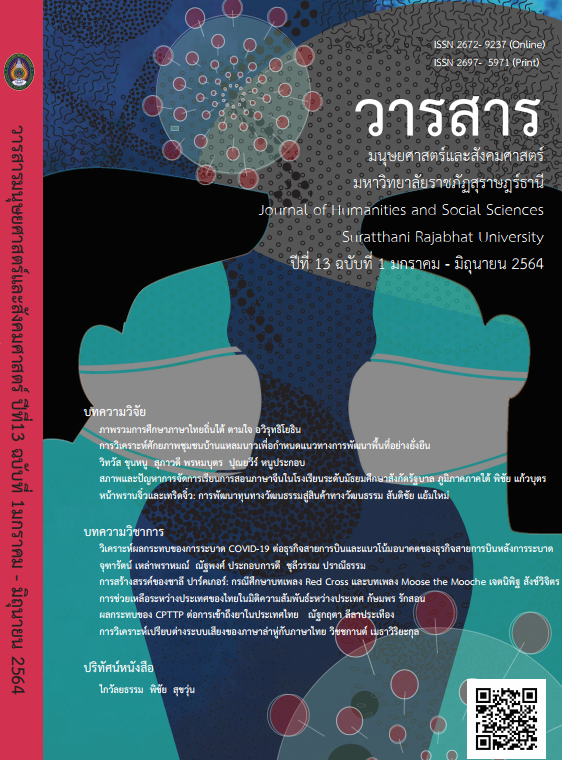Tiny Hunter's Face and Tiny Headdress: Cultural Capital Development to Cultural Products
Main Article Content
Abstract
The study on Tiny hunter's face and tiny headdress: cultural capital development to cultural products is based on a qualitative research method. The objective is to study the development of cultural capital into the cultural products of the tiny hunter's face and tiny headdress. The data were collected from texts and field documents with informal observations and informal interviews. The area of study is Trang. The study indicated that people in the South believe that the headdress and the hunter's face are the representatives of Krumor Nora, which is a holy spirit. Therefore, there was an the initiation of the invention of the headdress and hunter's face to create a talisman, which can be easily carried. Mr. Teung and his family, Trang people, are the family inventing the headdress and the hunter's face for sale. However, when 2016, the making of tiny headdresses and tiny hunters was initiated and improved. The concept of this work is the goal to increase the variety of products without destroying the traditional cultural base. At present, this product is highly demanded. This present study, therefore, proposed the future development of the work, namely the creation of Nora dolls and Huntsman dolls and hiring workers to help create the product appropriately. The analysis of the way of thinking in the work of Mr. Teung and family revealed that they relied on the concept, "Sufficiency Economy Philosophy.”
Article Details

This work is licensed under a Creative Commons Attribution-NonCommercial-NoDerivatives 4.0 International License.
All published manuscripts have been verified by peer-peer professors in the fields of humanities and social sciences. Reprinting of the article must be authorized by the editorial staff.
References
กนกวรรณ จงเจริญยิ่ง. (2549). มนุษย์ ชุมชน และเศรษฐกิจ. เชียงใหม่: สุเทพการ
พิมพ์.
พิทยา บุษรารัตน์. (2556). โนรา ฉบับทักษิณคดีศึกษา. สงขลา: บริษัท เอส พริ้นท์
(2004) จำกัด.
ภาควิชาสังคมวิทยาและมานุษยวิทยา คณะรัฐศาสตร์ จุฬาลงกรณ์มหาวิทยาลัย. (2546).
สังคมและวัฒนธรรม. พิมพ์ครั้งที่ 8. กรุงเทพฯ: บริษัทด่าน สุทธาการพิมพ์
จำกัด.
วรวุฒิ โรมรัตนาพันธ์. (2548). ทุนทางสังคม. กรุงเทพฯ: โรงพิมพ์เดือนตุลา.
วิเชียร เกษประทุม. (2553). เล่าเรื่อง ขุนช้าง-ขุนแผน. กรุงเทพฯ: ห้างหุ้นส่วนจำกัด
เรืองแสงการพิมพ์.
สนิท สมัครการ. (2549). มานุษยวิทยากับการพัฒนาสังคม. กรุงเทพฯ: โอเดียน
สโตร์.
สันติชัย แย้มใหม่ จิรัชยา เจียวก๊ก และอุทิศ สังขรัตน์. (เมษายน-ธันวาคม 2558).
โนรากับสุขภาวะของคนและชุมชน. ไทยคดีศึกษา. 12(2) : 150-176.
สันติชัย แย้มใหม่. (2560). โนราอันดามัน: ความเชื่อและพิธีกรรม. กรุงเทพฯ: โรงพิมพ์
เดือนตุลา.
บุคลานุกรม
ณัฐพงศ์ สัจบุตร. (ผู้ให้สัมภาษณ์). สันติชัย แย้มใหม่. (ผู้สัมภาษณ์). ณ บ้านช่างเทือง เมือง
ตรัง ตำบลนาข้าวเสีย อำเภอนาโยง จังหวัดตรัง. เมื่อวันที่ 14 มกราคม 2562.
ปฏิพัฒน์ สัจบุตร. (ผู้ให้สัมภาษณ์). สันติชัย แย้มใหม่. (ผู้สัมภาษณ์). ณ บ้านช่างเทือง
เมืองตรัง ตำบลนาข้าวเสีย อำเภอนาโยง จังหวัดตรัง. เมื่อวันที่ 14 มกราคม
ประเทือง สัจบุตร. (ผู้ให้สัมภาษณ์). สันติชัย แย้มใหม่. (ผู้สัมภาษณ์). ณ บ้านช่างเทือง
เมืองตรัง ตำบลนาข้าวเสีย อำเภอนาโยง จังหวัดตรัง. เมื่อวันที่ 14 มกราคม
ประสิทธิ์ คงแก้ว. (ผู้ให้สัมภาษณ์). สันติชัย แย้มใหม่. (ผู้สัมภาษณ์). ณ บ้าน บ้านพรานสิทธิ์
ตำบลโคกยาง อำเภอกันตัง จังหวัดตรัง. เมื่อวันที่ 25 มกราคม 2562.
มณฑา ชิตลธาร. (ผู้ให้สัมภาษณ์). สันติชัย แย้มใหม่. (ผู้สัมภาษณ์). ณ บ้านเลขที่ 31/1 หมู่
ที่ 5 ตำบลคลองลุ อำเภอกันตัง จังหวัดตรัง. เมื่อวันที่ 25 พฤศจิกายน 2561.


